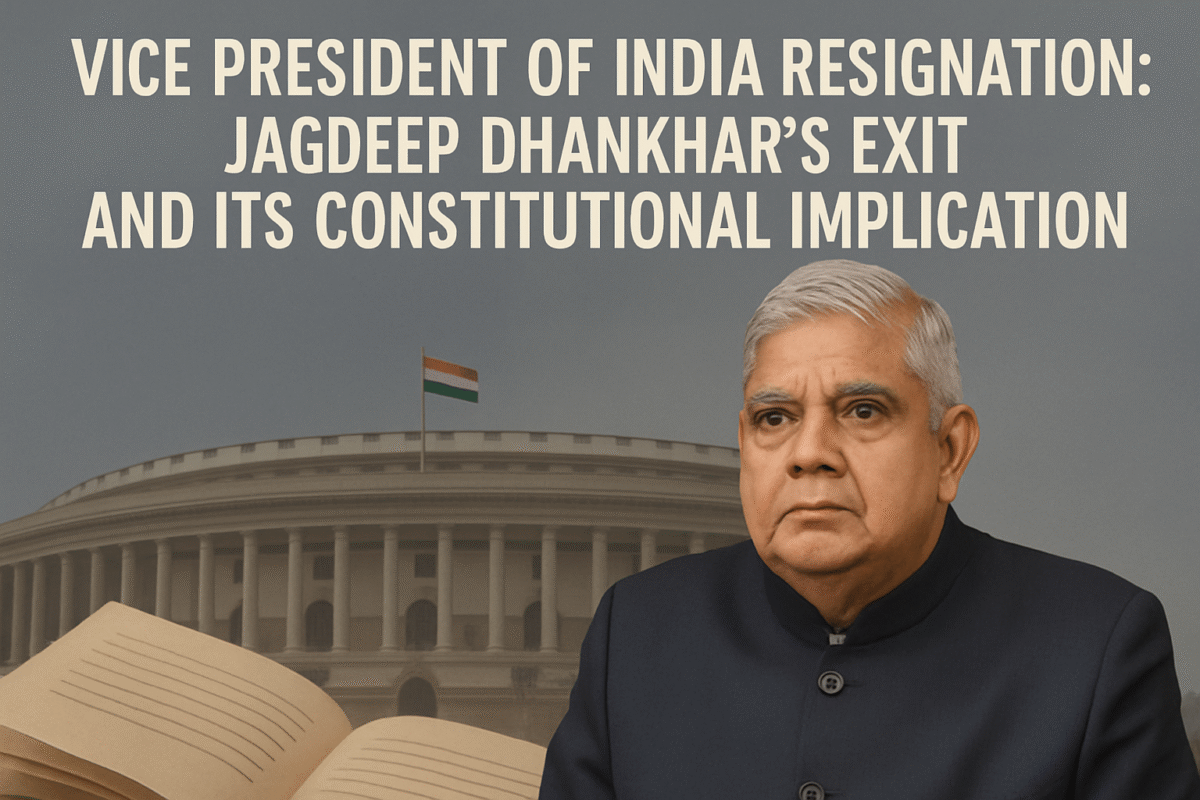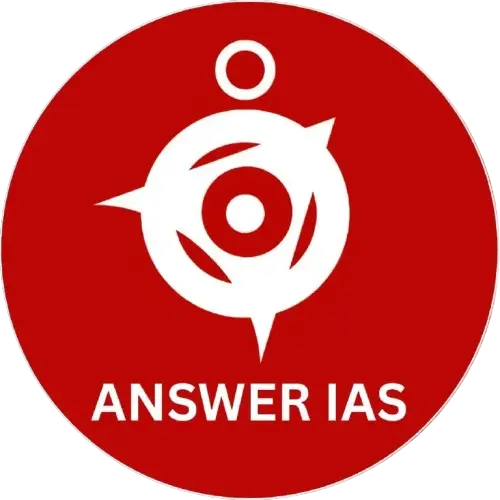
In a surprising turn of events, the Vice President of India resignation has taken the nation by storm. Jagdeep Dhankhar, the 14th Vice President of India, tendered his resignation amidst swirling speculation and political calculations. While resignations at such high constitutional offices are rare, their implications are far-reaching — especially in a parliamentary democracy like India.
This article critically examines Dhankhar’s resignation, its constitutional framework, political significance, and the immediate steps that follow, particularly from a UPSC polity and governance perspective.
Who is Jagdeep Dhankhar?
Jagdeep Dhankhar, elected as Vice President of India in August 2022, has had a long political and legal career. A former Governor of West Bengal and seasoned Supreme Court lawyer, he represented a combination of legal acumen and political maneuvering. His tenure witnessed assertiveness in the Rajya Sabha, especially during turbulent parliamentary sessions.
His resignation, barely midway through his five-year term, demands a deeper analysis of not just what happened, but why, and what next.
Why Did the Vice President of India Resign?
While official sources might cloak the development under the generic term “personal reasons,” in Indian politics such moves are rarely devoid of deeper motivations. Possible reasons behind the Vice President of India resignation could include:
- Political elevation: There is speculation about Dhankhar being positioned for a higher constitutional role, possibly as a presidential candidate in the future or for a crucial role within the ruling party structure.
- Disagreement with the government: While no such rift has been publicly acknowledged, tensions between the Vice President and ruling political elites can sometimes lead to premature exits.
- Health or personal reasons: A more conventional explanation, albeit often used as a cover for more strategic political reshuffles.
Constitutional Provisions Regarding Vice President Resignation
This brings us to the constitutional mechanism governing the office. As per Article 67(b) of the Indian Constitution:
“The Vice President may resign his office by writing under his hand addressed to the President.”
This provision lays out a straightforward resignation process, but the implications are layered. The resignation becomes effective once accepted by the President. There is no requirement for parliamentary approval or any formal debate.
Additionally, Article 65 states that in case of a vacancy in the office of the Vice President, the President may act as the Rajya Sabha chairman until a new VP is elected.
The Vice President constitutional provisions are part of static polity but gain dynamic relevance in such events — a critical integration point for UPSC aspirants.
What Happens After the Vice President Resigns?
1. Notification and Acceptance
Upon receiving the resignation letter, the President of India formally accepts it. A gazette notification is issued confirming the resignation.
2. Vacancy Declaration
The Rajya Sabha Secretariat declares the post vacant, triggering the electoral process under the Vice President Election Act, 1952.
3. Election Within Six Months
As per legal mandate and constitutional tradition, a new Vice President must be elected within six months of the vacancy.
The Election Commission of India (ECI) will:
- Notify the election schedule
- Set nomination deadlines
- Facilitate voting by an electoral college comprising members of both Houses of Parliament
The process resembles a mini-presidential election in terms of scale and political significance.
Political Implications of the Resignation
The Vice President of India resignation isn’t merely a bureaucratic vacancy. It has serious political overtones:
- Ruling coalition dynamics: If Dhankhar’s resignation is tied to internal re-alignments or upcoming 2026 Rajya Sabha elections, it signals strategic reshuffling.
- Opposition response: The resignation can open a window for consensus or confrontation, depending on the timing of the new VP election.
- Legislative balance: The Vice President, as the ex-officio Chairman of the Rajya Sabha, plays a pivotal role in maintaining order during contentious sessions. An acting chairman may not have the same authority or impact.
Historical Precedents: Has a Vice President Resigned Before?
Rarely. Among the 14 Vice Presidents of India, very few have resigned voluntarily:
- V.V. Giri (1969): Resigned to contest the presidential election following the sudden demise of President Zakir Husain.
- Others have either completed their terms or moved to the presidency.
This makes Jagdeep Dhankhar’s resignation a historic and uncommon event, warranting careful analysis.
Role of the Vice President: Static and Dynamic Relevance
For civil services aspirants, this incident is a perfect example of integrating static polity with dynamic current affairs. The Vice President of India UPSC relevance stems from his dual role:
- As Vice President: Second highest constitutional office after the President. Part of the executive hierarchy.
- As Chairman of the Rajya Sabha: Not a member of the House, yet presiding over it — a unique feature in Indian parliamentary democracy.
Understanding this dual nature helps aspirants decode parliamentary functioning and the nuances of constitutional checks and balances.
President Vice President Comparison: Why It Matters Now
In light of the resignation, the President-Vice President power balance comes into sharp focus:
| Aspect | President | Vice President |
|---|---|---|
| Constitutional Article | Article 52-62 | Article 63-71 |
| Election | Electoral college of MPs and MLAs | Electoral college of MPs only |
| Role | Executive Head of State | Deputy Executive and Legislative |
| Presides Over | None (Ceremonial Head) | Rajya Sabha |
| Resignation Addressed To | Vice President | President |
The constitutional provisions ensure that both posts function with synergy but retain independent identities. The Vice President constitutional provisions also help explain why such resignations are non-disruptive institutionally, though politically sensitive.
Next Steps: Who Will Be the Next Vice President of India?
While names are being floated across party lines, the next Vice President of India will likely be someone:
- Acceptable to both Houses of Parliament
- Politically strategic (caste, region, ideology)
- Capable of handling parliamentary deadlocks
Expect the ruling coalition to prioritize someone who can navigate both legal literacy and political loyalty.
Until then, the Deputy Chairman of the Rajya Sabha may perform ceremonial duties, though the President could also appoint an acting chairman.
Conclusion
The Vice President of India resignation is not just a headline. It is a live case study in constitutional democracy, political strategy, and institutional continuity. For those tracking current affairs, especially UPSC aspirants, this development bridges static knowledge with dynamic interpretation.
Jagdeep Dhankhar’s exit sets in motion a complex series of events — legal, electoral, and political. As the nation watches who the next Vice President of India will be, one thing remains clear: the Indian Constitution has a contingency for every uncertainty, even when the second highest constitutional officer resigns.
FAQs (Vice President of India Resignation Context)
Q: What is the term of the Vice President of India?
A: 5 years, but he/she can resign before term completion by addressing the President.
Q: Can the Vice President be impeached?
A: No, unlike the President, the Vice President can be removed by a resolution passed by a majority in the Rajya Sabha and agreed to by the Lok Sabha (Article 67(c)).
Q: Who acts as Vice President if the seat falls vacant?
A: There is no formal acting Vice President. However, Rajya Sabha proceedings may be presided over by the Deputy Chairman or another designated member.
Q: Where are VP provisions found in the Constitution?
A: Articles 63 to 71 deal with the Vice President, his election, removal, and duties.
Reference Article
- Articles 63–70 of the Indian Constitution
- Rajya Sabha Powers of the Vice President
- Official Vice President of India Website
UPSC Preparation Related Posts
- IAS power vs IPS power: Comprehensive Comparison of Roles, Power, and Career Paths in 2026
- Complete UPSC 2026–27 Strategy Guide – Preparation Without Coaching
- How to Balance UPSC Preparation with a Job or College, Lessons from UPSC Toppers ?
- UPSC Toppers Expose the Top 10 Mindsets That Took Them to UPSC Rank 1

Leave a Reply